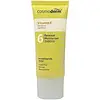What's inside
What's inside
 Key Ingredients
Key Ingredients

 Benefits
Benefits

 Concerns
Concerns

 Ingredients Side-by-side
Ingredients Side-by-side

Water
Skin ConditioningTocopheryl Acetate
AntioxidantHelianthus Annuus Flower
Skin ConditioningDimethicone
EmollientGlyceryl Stearate
EmollientPEG-100 Stearate
Isopropyl Myristate
EmollientStearic Acid
CleansingCaprylic/Capric Triglyceride
MaskingEthylhexyl Methoxycinnamate
UV AbsorberGlycerin
HumectantTocopherol
AntioxidantRosa Moschata Seed Oil
EmollientAscorbyl Palmitate
AntioxidantDisodium EDTA
Hydroxypropyl Methylcellulose
Emulsion StabilisingBHT
AntioxidantCarbomer
Emulsion StabilisingTromethamine
BufferingParfum
MaskingPhenoxyethanol
PreservativeSorbitan Caprylate
EmulsifyingWater, Tocopheryl Acetate, Helianthus Annuus Flower, Dimethicone, Glyceryl Stearate, PEG-100 Stearate, Isopropyl Myristate, Stearic Acid, Caprylic/Capric Triglyceride, Ethylhexyl Methoxycinnamate, Glycerin, Tocopherol, Rosa Moschata Seed Oil, Ascorbyl Palmitate, Disodium EDTA, Hydroxypropyl Methylcellulose, BHT, Carbomer, Tromethamine, Parfum, Phenoxyethanol, Sorbitan Caprylate
Water
Skin ConditioningGlycerin
HumectantCocamidopropyl Betaine
CleansingAmmonium Lauryl Sulfate
CleansingSodium Cocoyl Alaninate
Acrylates Copolymer
PEG-6 Caprylic/Capric Glycerides
EmulsifyingPEG-8
HumectantSodium Hydroxide
BufferingDisodium EDTA
Benzophenone-4
UV AbsorberSalicylic Acid
MaskingHelianthus Annuus Seed Oil
EmollientGlycine Soja Oil
EmollientPEG-7 Glyceryl Cocoate
EmulsifyingPrunus Amygdalus Dulcis Oil
Skin ConditioningCalendula Officinalis Flower Extract
MaskingLavandula Angustifolia Oil
MaskingCeramide 3
Skin ConditioningAnthemis Nobilis Flower Oil
MaskingRosmarinus Officinalis Leaf Oil
MaskingTocopherol
AntioxidantPhenoxyethanol
PreservativeChlorphenesin
AntimicrobialSodium Metabisulfite
AntioxidantWater, Glycerin, Cocamidopropyl Betaine, Ammonium Lauryl Sulfate, Sodium Cocoyl Alaninate, Acrylates Copolymer, PEG-6 Caprylic/Capric Glycerides, PEG-8, Sodium Hydroxide, Disodium EDTA, Benzophenone-4, Salicylic Acid, Helianthus Annuus Seed Oil, Glycine Soja Oil, PEG-7 Glyceryl Cocoate, Prunus Amygdalus Dulcis Oil, Calendula Officinalis Flower Extract, Lavandula Angustifolia Oil, Ceramide 3, Anthemis Nobilis Flower Oil, Rosmarinus Officinalis Leaf Oil, Tocopherol, Phenoxyethanol, Chlorphenesin, Sodium Metabisulfite
 Reviews
Reviews

Ingredients Explained
These ingredients are found in both products.
Ingredients higher up in an ingredient list are typically present in a larger amount.
Disodium EDTA plays a role in making products more stable by aiding other preservatives.
It is a chelating agent, meaning it neutralizes metal ions that may be found in a product.
Disodium EDTA is a salt of edetic acid and is found to be safe in cosmetic ingredients.
Learn more about Disodium EDTAGlycerin is already naturally found in your skin. It helps moisturize and protect your skin.
A study from 2016 found glycerin to be more effective as a humectant than AHAs and hyaluronic acid.
As a humectant, it helps the skin stay hydrated by pulling moisture to your skin. The low molecular weight of glycerin allows it to pull moisture into the deeper layers of your skin.
Hydrated skin improves your skin barrier; Your skin barrier helps protect against irritants and bacteria.
Glycerin has also been found to have antimicrobial and antiviral properties. Due to these properties, glycerin is often used in wound and burn treatments.
In cosmetics, glycerin is usually derived from plants such as soybean or palm. However, it can also be sourced from animals, such as tallow or animal fat.
This ingredient is organic, colorless, odorless, and non-toxic.
Glycerin is the name for this ingredient in American English. British English uses Glycerol/Glycerine.
Learn more about GlycerinPhenoxyethanol is a preservative that has germicide, antimicrobial, and aromatic properties. Studies show that phenoxyethanol can prevent microbial growth. By itself, it has a scent that is similar to that of a rose.
It's often used in formulations along with Caprylyl Glycol to preserve the shelf life of products.
Tocopherol (also known as Vitamin E) is a common antioxidant used to help protect the skin from free-radicals and strengthen the skin barrier. It's also fat soluble - this means our skin is great at absorbing it.
Vitamin E also helps keep your natural skin lipids healthy. Your lipid skin barrier naturally consists of lipids, ceramides, and fatty acids. Vitamin E offers extra protection for your skin’s lipid barrier, keeping your skin healthy and nourished.
Another benefit is a bit of UV protection. Vitamin E helps reduce the damage caused by UVB rays. (It should not replace your sunscreen). Combining it with Vitamin C can decrease sunburned cells and hyperpigmentation after UV exposure.
You might have noticed Vitamin E + C often paired together. This is because it is great at stabilizing Vitamin C. Using the two together helps increase the effectiveness of both ingredients.
There are often claims that Vitamin E can reduce/prevent scarring, but these claims haven't been confirmed by scientific research.
Learn more about TocopherolWater. It's the most common cosmetic ingredient of all. You'll usually see it at the top of ingredient lists, meaning that it makes up the largest part of the product.
So why is it so popular? Water most often acts as a solvent - this means that it helps dissolve other ingredients into the formulation.
You'll also recognize water as that liquid we all need to stay alive. If you see this, drink a glass of water. Stay hydrated!
Learn more about Water